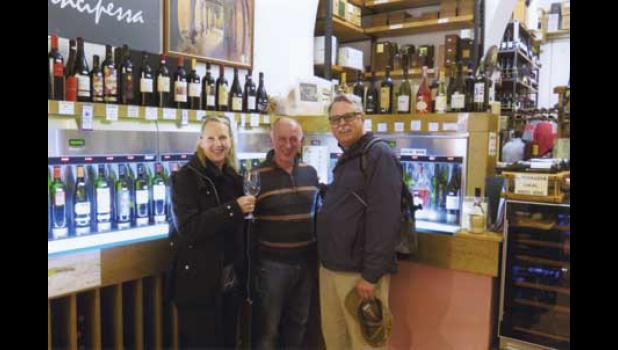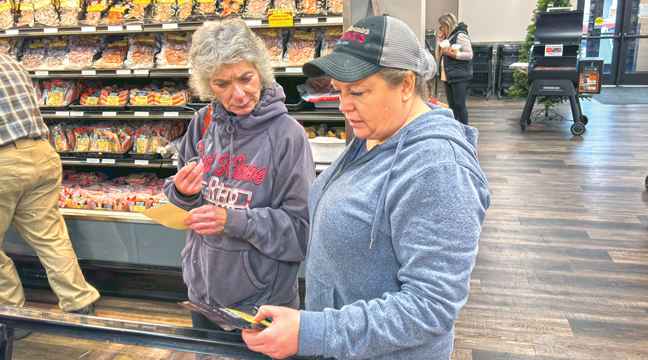(EDITOR’S NOTE: The following is the conclusion of a three-part series on Publisher Gary W. Meyer’s October trip through Italy with Naturalist Jim Gilbert, his wife Sandy and a cast of two dozen Minnesotans)
The afternoon after touring Assisi had lent itself to a steady rain.
I wasn’t bothered. We were within minutes of a visit that had captured my imagination since the day I first saw the itinerary for the trip. An afternoon at an historic Tuscan vineyard, Castello Vicchio Maggio, was awaiting.
Trees of the countryside, just undergoing the effects of autumn, had lost a few of their leaves.
The whiteness of the next scene stopped my eyes cold.
We whisked by what appeared to be an American military cemetery, white crosses standing in their neat rows. No time for a stop, the tour director emphasized. I took a last glimpse.
It’s worthy we delay our talk about wine for a few moments, while remembering the Florence American Cemetery, a final resting place to 4,402 Americans, and another 1,409 missing in action in World War II, 1944-45. Their 70-acre site was given to the Americans and dedicated later - in 1960.
At rest among those pleasant hills were American troops, fresh from the liberation of Rome June 5, 1944, heading northward to confront more Germans in the Apennines, a mountain range which was a central backbone to the country.
Majority of the soldiers were from the US Fifth Army and the British Eighth Army.
I would like to have visited you, soldiers. I hope you are resting in peace.
The Vineyard
John Matta, owner and vintner at Castello Vicchio Maggio, had a dream when he and his wife purchased the 400-acre site in 1964.
His dream was to make excellent chianti wines, revered gift to the world from Tuscany. Over the years, that dream kept taking shape, until in the early 2000s, he was acclaimed the top vintner in the whole of Italy.
He was given that accolade three more times since, most recently in 2013.
Our group delighted in three wine tastings with his hospitality director, Ines Vitali. The Chianti Classico, first vinted in 1852, and since refined to become a national award-winner, is comprised 80% of local grapes. It must have that makeup to be a classical. The chianti region in Italy extends from Florence in the north 60 miles south to Siena.
The 400-acre estate outside was at rest, having given up the last of its 100 acres of grapes just a few days prior.
Forty workers toiled for 10 days to complete the harvest, which ended Oct. 10. From those 100 acres will come enough grapes to fill 350,000 litre bottles.
The grapes had undergone cleaning and were being prepared for the fermantation barrels, 2,500 and 5,000-litre barrels.
They would be allowed to ferment at 20-21 degrees C. for a year to be the Classico; two years, the Reserva. The two bottles I brought home were the Reserva, at $11 Euro. Dinner guests raved over the first bottle.
Fermentation barrels are a big expense in vintning, Ines said. They cost about 50,000 Euro, or $55,000 our money. But, they last for 40 years.
Matta has the land to expand his vineyard but refuses to do so. He devotes, 10 acres each year to growing olive trees, which produce virgin olive oil for cooking and some magnificent hand cream. Try skin lotion with extra virgin olive oil sometime. You’ll experience a healing treat.
Ines, a native South African who immigrated to Europe, later Italy, 20 years ago, is in love with her job and the Tuscan countryside.
She was surely tired from the long harvest just concluded, then to be hosting chattering American tourists.
Is this lifestyle as romantic as it appears? I questioned her.
Every bit, so, she replied.
Fabulous Arts
Florence is known as the center of arts and culture in Italy. It didn’t disappoint. Among our visits were the Piazza della Signoria, the Boboli Gardens and the Accademia Gallery, where we gazed upon Michaelangelo’s 15-foot Statue of David.
Michaelangelo, of Florence, was a sculptor by profession. (But he was so talented the Vatican called him in to do a frescoe on the ceiling of the Sistene Chapel.
Not a painter, he studied the art for two years before accomplishing that masterpiece. “Painting is for the ladies,” he said in defiance.)
It took four years for Michaelangelo to complete David, quarried from a mountain of marble just outside Florence. And how good was he at it?
Years after his completion of the sculpture, medical people were brought in to analyze the details of his work. The veins in his arms were perfect. The sinue in his muscles were perfect, they said. Remarkable. And it was the turn of the 15th Century. It took him nine months to polish the art.
About the same time Michaelangelo was at work in Florence, a fellow countryman was making his mark with the painting of the Lords Supper, from 1496-98, in a Milan cathedral.
Leonardo di Vinci was commissioned for that painting, done on a 30-foot wide wall.
The painting nearly met its fate in August, 1943, as British airplanes bombed Milan, an industrial hub, into submission. A bomb landed just outside the wall bearing the painting. The wall wavered - but the painting stayed intact. It was restored in 1977.
Whereas Rome is ancient, Milano is very modern, due to its rebuilding.
(An equally impressive painting of The Crucifixion, by Giovanni donto de in 1495, graced the opposite wall.)
Two of the greatest artists in the world didn’t like each other. di Vinci was stuffy and impetuous; Michaelangelo. He didn’t care what others thought of him. And, they lived at the same time.
A Wrap-Up
Our northerly travels to us to the sunny Cinque Terre on the west coast, via a fast train (180 mph) over to Venice, then by bus to Lake Como, the fabulous resort region just into the southern Alps.
Each provided their beautiful sites and stories. In Milano, the original Galleria. Money was oozing from the sidewalks. Next door, the Duomo, a Gothic church which took 500 years to build. It was also hit by the Allied bombings.
During a boat ride on Lake Como, our tour director pointed out the mountain home of American actor George Clooney and his Italian lawyer wife. Their digs, a nice three story white home with yellow roof - or was it the yellow home with a white roof?
Italy’s northern industrial sector actually, which is in very good condition, runs the country, our guide reported.
The country, especially in the south, is having a hard time with the invasion of Syrian refugees, who are trying to impose their religious and cultural will on the more liberal Italians.
But the Italians are not a nationalistic bunch; rather, very territorial.
“You’ll only see our flag out if we win a championship in something,” our guide said.
“And if there is something wrong, we complain, but we don’t do anything about it.”
Many years ago, the Italians were doing a lot of things right. They’re worth the visit.









